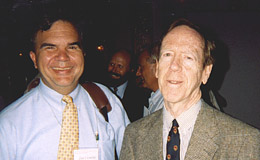
2003 SIAM Annual Meeting
The 2003 Annual Meeting of the Society for Industrial and Applied Mathematics (SIAM) was a joint meeting of SIAM with the Canadian Applied and Industrial Mathematics Society (Société Canadienne de Mathématiques Appliquées et Industrielles). Over 500 people attended the meeting, held in Montreal from June 16 to 20. What follows is a short description of some of the talks at the meeting and one of the prizes awarded.
Most people would guess that the more regular an electrocardiogram (ekg), the healthier the patient; yet a healthy heartbeat is actually very complex. The heart is part of a non-linear, coupled feedback system involving the brain and autonomous nervous system. Goldberger showed the audience several ekg's, the most regular of which was that of a patient in heart failure (this ekg was periodic but not flat). An ekg with too much variability came from a patient in fibrillation. The ekg from the healthiest patient was fractal over several time scales. Goldberger pointed out that the fractal exponent varies with age and health so that a relevant question for a heart patient to ask regarding heart medication is: What is this drug going to do to my fractal dimensionality?
Rundell opened the meeting saying that now is "an enormously interesting time to be at NSF." Along with the increase in NSF funding of mathematics, mathematics is now one of the Foundation's six priority areas (usually priority areas are cross-disciplinary topics like nanotechnology). There is funding for mathematics research and interdisciplinary research, for increasing the number of undergraduate mathematics majors who go to graduate school, and for improving the connections between research mathematicians and high school teachers. Some of these goals are part of the VIGRE (Vertical Integration of Research and Education) program. Rundell talked at length about getting more undergraduate mathematics majors to go to graduate school, saying that "in three to five years, we've got to double the number of math majors going on to graduate programs in the sciences." He added that this isn't to be accomplished by convincing unprepared students to go to graduate school but rather by getting more undergraduates to major in mathematics. Also, although it may seem that talking about math majors continuing their studies in anything except mathematics admits a loss of math students, currently less than half of math majors who go to graduate school enroll in graduate mathematics programs. As for the nuts and bolts of the job, Rundell said that he was finishing the 2003 budget, hoping that the 2004 budget will go through, and putting together the 2005 budget.
Kaiser reviewed the history of producing human speech and of speech recognition. Models used until recently were linear which Kaiser said did not capture the behavior of waves produced by vocal cords. As evidence of the inadequacy of those models, some velocities associated with the vocal tract are more than 100 times what is predicted by the models. Currently, we are unable to distinguish between a mynah bird's "speech" and ours, despite the vast differences between the bird's vocal cords and brain, and ours.
Among the prizes given by SIAM was the SIAM Prize for Distinguished Service to the Profession, which was awarded to Gilbert Strang of the Massachusetts Institute of Technology. Strang was recognized for "his many contributions to applied mathematics and for his service to the mathematics community." The prize citation also noted that "It is all but impossible to work in applied and computational mathematics without being influenced by Gil's mathematical contributions."
Although there has been an improvement in the accuracy of weather forecasting, our knowledge of climate is still meager. McWilliams listed some issues in climate science, like turbulence and "lurking catastrophes" such as an ice age, and talked about areas where mathematics could help (for example, signal detection and model well-posedness). No science is prepared to solve all the problems associated with climate, but McWilliams said that mathematics will help by "working in the margins between importance and irrelevance, and tractabliity and impossibility." He also mentioned that the current temperature and carbon dioxide changes "are without precedent on a millennial scale."
Cook gave an entertaining and informative lecture on the Traveling Salesman Problem (TSP), its applications, and algorithms that succeed in near-optimal solutions to particular instances of the problem. Applications of the TSP include designing telecommunication networks, drilling printed circuit boards, and finding the positions of genes. The best algorithms for solving such problems work locally, dividing up the vertices ("cities") into subcollections, finding a good path for a collection and then moving on to another. Cook explained how linear programming is used to determine costs of optimal solutions so that an algorithm's performance can be measured. Amazingly, current algorithms working on graphs with millions of vertices can get within 0.008% of an optimal solution.
Next year's SIAM annual meeting is in Portland, Oregon.
The photograph of William Rundell was taken by Professor Samuel Shen (University of Alberta).
Visit the SIAM website for more information.
Highlights from the 2002 SIAM annual meeting can be found here.





